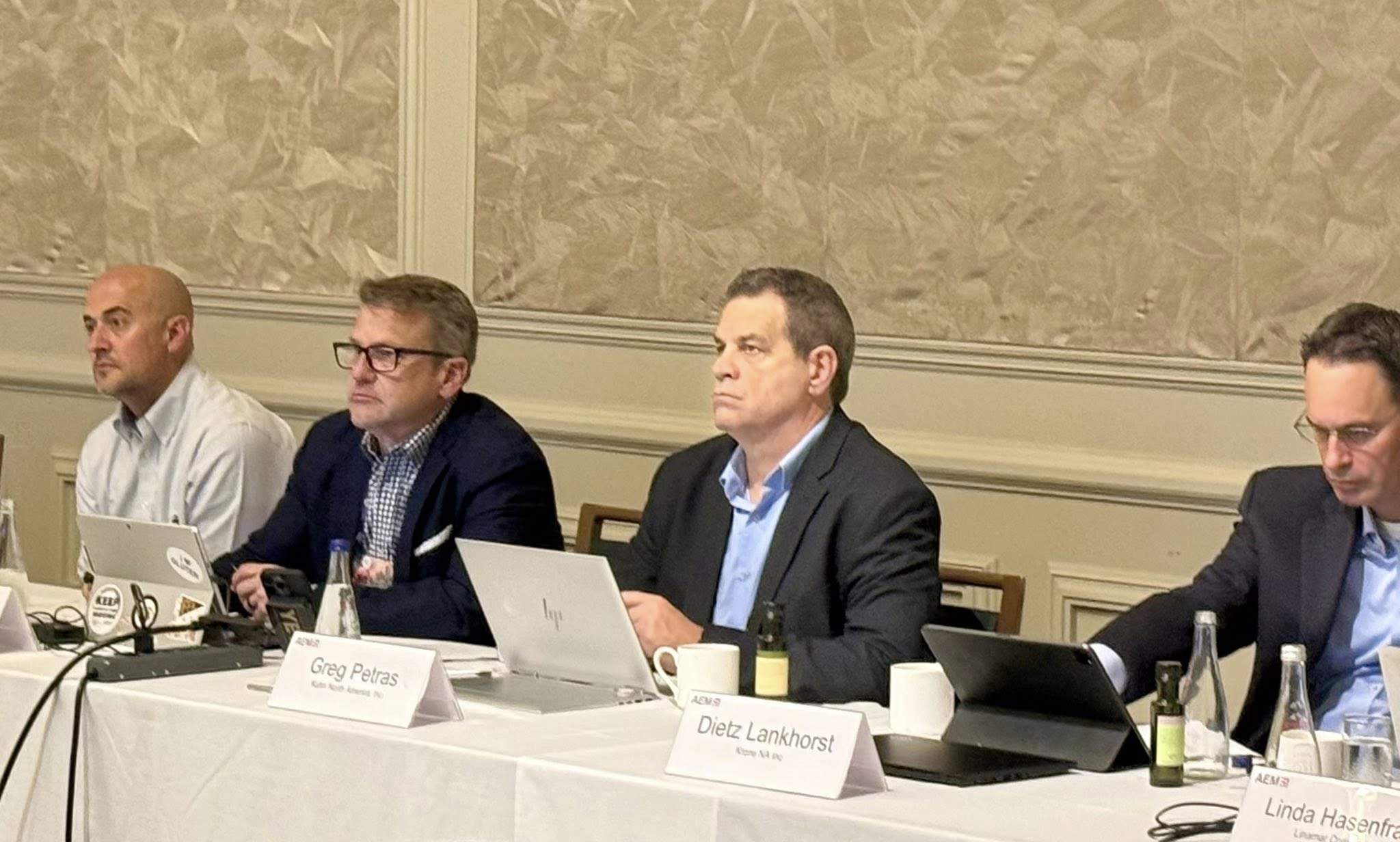As ag and construction equipment offerings evolve with time, so do the regulations aimed at addressing what products are made of, how they’re manufactured, and how they’re used.
The responsibility to know, understand, and comply with regulatory activity rests squarely on the shoulders of equipment manufacturers. The bare minimum is to be aware of what legal requirements currently exist. However, manufacturers would be wise to also start working ahead and develop a roadmap for securing the information necessary to stay on top of, and in front of, what lies ahead.
With that fact in mind, here are five areas of interest related to regulation AEM Safety & Product Leadership and agriculture leaders are focused on as 2024 gets underway:
 Chemicals
Chemicals
By Jason Malcore, AEM Senior Director of Safety & Product Leadership
HFCs
On Dec. 27, 2020, Congress passed the American Innovation and Manufacturing Act (AIM Act), which formally adopted the administrative provisions of the Kigali Amendment to the Montreal Protocol. The Kigali amendment to the Montreal protocol requires signatory countries to replace their current refrigerants, like HFC-134a, with low global warming potential (GWP) substances. Specifically, the Kigali amendment seeks to gradually phasedown the production of high GWP hydrofluorocarbons by 80-85% over the next several decades. Policymakers estimate that the scarcity of HFC supply and the associated price increases will encourage manufacturers to adopt more climate-friendly refrigerant solutions for their products.
In late 2023, using several provisions from the AIM Act, EPA finalized a rule accelerating the timeline for nonroad equipment to fully transition away from HFC-134a by 2028, seven years earlier than the pre-existing timetable. EPA is not the only agency introducing similar accelerated timelines for transitioning away from HFCs. AEM is seeing similar regulations creeping up in various jurisdictions, such as Washington State and the European Union.
The impact of these new requirements will force manufacturers to complete universal design requirement changes simultaneously across different product lines, as well as stress the supply chain to meet the surge in demand across multiple industries. Companies looking to stay ahead of these types of changes will need to stay up to date on new regulations and remain flexible in their strategies to meet address these new requirements in 2024 and beyond.
PFAS
In 2023, industry experienced a barrage of new regulatory proposals regarding the reporting, recordkeeping, and restriction of Per- and Polyfluoroalkyl Substances (PFAS). These regulatory proposals included:
- EU REACH Restriction Proposal - PFAS
- EPA PFAS Reporting and Recordkeeping Rule
- Canada Risk Management Scope for PFAS
- Maine PFAS in Products Regulation
- Minnesota PFAS Ban
PFAS are a large family of synthetic compounds which contain thousands of unique chemical entities. For many manufacturers, including the non-road sector, PFAS are selected to provide a variety of highly advantageous properties in crucial component systems and can be found in almost all non-road equipment. Unfortunately, PFAS chemicals are also highly stable chemicals, able to last thousands of years without degrading or breaking down in the environment. This longevity, combined with concerns over their alleged toxicity, has spurred numerous legislative and regulatory actions against the use of these chemicals around the world.
As we move into 2024 and beyond, PFAS will continue to draw significant attention from the public, politicians, and various regulatory agencies. Equipment manufacturers should expect to see many of these current regulatory proposals finalized, as well as see the introduction of new rules and requirements in a host of new states, countries, and regions.
The sheer size of this issue necessitates a coordinated response and strategy from industry, not only to help educate policymakers on the impact of restricting the use of PFAS, but to help manufacturers and their supply chain partners meet the compliance requirements associated with these new rules. AEM will continue to bring industry subject matter experts together to provide solutions and educate our member companies.
 Off-Road Diesel Engine Emissions
Off-Road Diesel Engine Emissions
By Travis Webb, AEM Safety & Product Leadership Technical Manager
The topic of diesel engine emissions remains top of mind for AEM members as the California Air Resources Board (CARB) continues to develop its Tier 5 off-road diesel engine standards to help California comply with the EPA’s National Ambient Air Quality Standards (NAAQS). With the most recent proposals introduced during CARB’s October 2023 workshop, CARB staff are targeting drastic reductions of both nitrogen oxides (NOx) and particulate matter (PM) with respect to current U.S. EPA Tier 4F emissions standards. Additionally, further GHG emission reductions are expected in future proposals such as the Off-Road Zero-Emission Targeted Manufacturer Rule (TMR), tentatively scheduled for CARB Board consideration sometime in 2027.
To ensure that the interests of the off-road equipment manufacturers and suppliers are considered and understood during these rulemaking activities, AEM continues to interact with its members through a variety of means (including the Engine Emissions Technical Committee (EETC), Engine Emissions Strategy Task Force, and advocacy outreach), which has recently increased its presence in the California regulatory and legislative landscape. Through these avenues, AEM and its member stakeholders can engage with CARB staff to ask questions, seek clarification, and provide industry consensus positions when necessary.
So, what are the next steps? CARB indicated that the Tier 5 proposals will be taken to the CARB Board for consideration in June of 2025. In the meantime, AEM will continue to work closely with CARB staff to share the expertise and technical knowledge of our industry on any future proposals or draft language that is presented. This will likely include opportunities to coordinate with other industry stakeholders to strengthen our positions where applicable and to schedule face-to-face meetings with CARB staff.
 Pesticides
Pesticides
By Nick Tindall, AEM Senior Director of Regulatory Affairs
In late 2023, the Environmental Protection Agency (EPA) sought comments on pesticide mitigation methods as they relate to the Endangered species Act (ESA). While AEM was pleased to see the agency recognize that spray drift technologies do offer tangible benefits to the ecosystem, we were disappointed EPA feels there is not enough data beyond hooded sprayers to declare their use as an ESA mitigation option.
EPA listing the use of common drift reduction technologies as a mitigation option would allow producers to spray with smaller buffer strips, therefore encouraging adoption. AEM is in contact with EPA and plans to leverage the expertise contained in our Crop Production Equipment Technical Committee (CPETC) and Sprayer Leadership Group to work with EPA to provide them the necessary data.
From 2009 to 2016, AEM was heavily engaged with EPA on the use of treated seed in pneumatic planters. Our outreach prevented the development of regulations that would have dictated design features. The industry’s establishment and wide adoption of an ISO standard to control fugitive dust from planters was the key to our success.
While EPA was satisfied with our efforts, many environmental groups continue to apply pressure on the agency to do more. EPA is taking another look at the use of treated seed, and AEM is conducting outreach to educate policymakers on the updated ISO standard as well as its wide scale use on today’s farms. Effective outreach will hopefully put this issue to rest for another eight years.
 Environmental, Social, and Corporate Governance (ESG)
Environmental, Social, and Corporate Governance (ESG)
By Al Melhim, AEM Senior Director of Agriculture
Sustainability, corporate social responsibility, or ESG, synonymous terms that cover environmental, social, and economic impacts of an organization, are increasingly becoming essential themes across businesses of all sizes. Many mandatory regulations, including, for example, government standards for Greenhouse Gas Emission reporting and disclosures, are changing the way businesses view their operations’ environmental footprint. The scale, scope, and complexity of these regulations, however, are overwhelming businesses, often leading to confusion and frustration among stakeholders, and in extreme cases, to discontent and pushback.
Nevertheless, the days when ESG reporting regulations were ignored by business owners and operators, (or unincorporated as fundamental forward-looking business strategies) are behind us. The number of mandatory regulations is bound to increase in the future, with far-reaching implications. In 2024, three pending regulatory frameworks are expected to be finalized, almost doubling the total number of regulatory frameworks that became mandatory over the last year. Equipment manufacturers and their supply chains are therefore highly advised to engage proactively with current regulations (and be on the lookout for upcoming ones).
|
ESG Regulations |
Status |
Year |
Origin |
|
The Sustainable Finance Disclosure Regulation (SFDR) |
Mandatory |
2023 |
EU Parliament |
|
The Corporate Sustainability Reporting Directive (CSRD) |
2023 |
EU Parliament |
|
|
The EU Taxonomy |
2023 |
UK Government |
|
|
The German Supply Chain Due Diligence Act (the LkSG) |
2023 |
German Parliament |
|
|
Streamlined Energy and Carbon Reporting (SECR) |
2019 |
UK Government |
|
|
The Corporate Sustainability Due Diligence Directive (CSDDD) |
Pending |
2024 |
EU Parliament |
|
Sustainability Disclosure Requirements (SDR) |
2024 |
UK Financial Conduct Authority |
|
|
Scope 3 Emissions Rule |
2024 |
US SEC |
In addition to the regulatory pressure, investors, insurers, shareholders, and consumer groups are expected to increase their demand for a more transparent and consistent ESG reporting so they can effectively hold businesses accountable for their ESG emissions. Acquiring the necessary data and developing the right quantitative tools to achieve such transparent and consistent reporting are complex, and they require large investments. While large businesses could arguably build the infrastructure and the teams for ESG reporting, smaller businesses will find it burdensome to do so. Equipment manufacturers and their suppliers are therefore encouraged to increase collaboration and be open to sharing experiences, lessons learned, and best practices. In doing so, they can help minimize or even alleviate some of that burden on small-size business owners and operators for the sake of the entire industry and its supply chain. Sparing no efforts in building alignment will lead to high efficiency gains and enhance the industry’s record of environmental stewardship and ethical conduct, a win-win outcome for the entire industry.
In view of the above, AEM has been doubling down on its efforts to help the industry sprint onto the right direction. Via AEM’s Sustainability Council and active member engagements, AEM has already celebrated two major milestones: The launch of AEM’s Sustainability Toolkit and the recently released guiding document for off-road GHG Protocol for Scope 3 Category 11 Emissions. Also, the Council is proactively engaging with members to find the most feasible way to roll-out an ESG reporting platform that would harmonize and streamline both the data collection process and quantitative disclosures among all stakeholders in the supply chain.
 Cybersecurity
Cybersecurity
By Austin Gellings, AEM Director of Agriculture
The off-road equipment industry has experienced a technological revolution over the past few years. Equipment from all off-road sectors continues to become smarter and more efficient, utilizing data and connectivity to provide operators and equipment owners more insight into their operations. This allows them to make more well-informed decisions to help their bottom line, all while being more sustainable.
However, as equipment continues to become more interconnected and more data is gathered, cybersecurity is becoming a topic of greater significance. As an industry, we work tirelessly to ensure that equipment is safe and secured, and that the same can be said for the data being gathered.
This transformation is courting attention from the regulatory space as well. In response to interest from groups like National Institute of Standards and Technology (NIST), FBI, and the U.S. Department of Homeland Security (DHS), AEM launched the Cybersecurity Committee, which is tasked with helping to lead our association’s work in this space. The group is already making an impact by providing comment on the NIST Cybersecurity Guidelines and engaging in conversations surrounding data security and storage. This is also a topic that is sparking engagement from AEM’s Ag and CE Technology Leadership Groups. Over the course of the last year, the Ag Technology Leadership Group gave presentations to DHS, FBI, and CSAN regarding the needs of the industry. As AEM continues to traverse the new world of cybersecurity, and help address whatever issues the industry is facing, we encourage members to reach out and engage with the Cybersecurity Council.
Subscribe to the AEM Industry Advisor for more perspectives from AEM staff.





